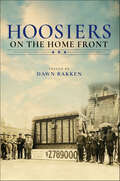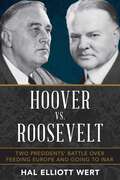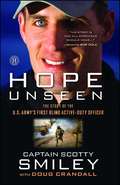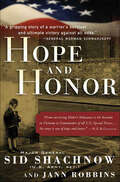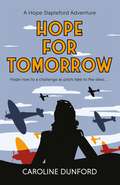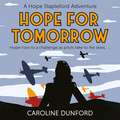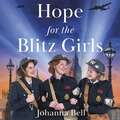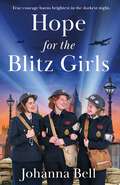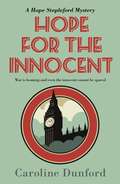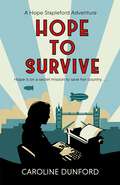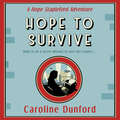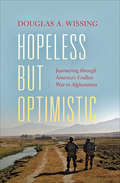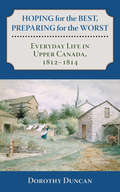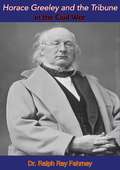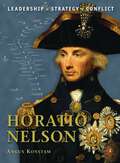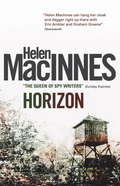- Table View
- List View
Hoosiers on the Home Front
by Dawn BakkenWars are fought on the home front as well as the battlefront. Spouses, family, friends, and communities are called upon to sacrifice and persevere in the face of a changed reality. Hoosiers on the Home Front explores the lives and experiences of ordinary Hoosiers from around Indiana who were left to fight at home during wartimes. Drawn from the rich holdings of the Indiana Magazine of History, a journal of state and midwestern history published since 1905, this collection includes original diaries, letters and memoirs, and research essays—all focused on Hoosiers on the home front of the Civil War through the Vietnam War. Readers will meet, among others, Joshua Jones of the 19th Indiana Volunteer Regiment and his wife, Celia; Attia Porter, a young resident of Corydon, Indiana, writing to her cousin about Morgan's Raid; Civil War and World War I veterans who came into conflict over the Indianapolis 500 and Memorial Day observances; Virginia Mayberry, a wife and mother on the World War II home front; and university students and professors—including antiwar activist Howard Zinn and conservative writer R. Emmett Tyrrell Jr.—clashing over the Vietnam War.Hoosiers on the Home Front offers a compelling glimpse of how war impacts everyone, even those who never saw the front line.
Hoover vs. Roosevelt: Two Presidents' Battle over Feeding Europe and Going to War
by Hal Elliott WertHerbert Hoover, out of office since his defeat in 1932 by Franklin Roosevelt, maintained a strong international reputation due to his achievements as an engineer and his success during World War I and beyond in organizing aid for the starving millions of Europe. And yet, in nearly all accounts of the ferocious debate over American aid to Europe before the United States entered World War II, Hoover&’s role has been overlooked. Hoover vs. Roosevelt tells the story of American efforts to stay out of war following the German invasion of Poland. Historian Arthur Schlesinger, Jr., called it &“the most savage political debate of my lifetime.&” Both men fiercely disagreed on how to respond but the heart of their disagreement was over aid for the huge numbers of Polish refugees flooding into neighboring countries and those that were left behind. Hoover found Roosevelt&’s policy of limited emergency aid unacceptable, countering by rapidly assembling teams comprised of talented people who had served in prior Hoover relief organizations. Here for the first time are the courageous stories of those that achieved that success in Romania, Hungary, and Lithuania. When the Soviets invaded Finland on November 30, Hoover assisted the Finns by conducting a Hollywood, star-studded campaign spearheading nation-wide support for this small country. But Hoover&’s relief efforts were complicated by his burning ambition to obtain the Republican presidential nomination, a second opportunity to defeat Roosevelt. For Roosevelt, Hoover&’s relief successes threatened to derail his limited aid policy which aimed to conserve resources to assist Britain and France and could also cost the president votes. Politics aside, Hoover wars in the first year of the war succeeded in forcing Roosevelt to provide far more aid then intended. Hoover&’s victory, the only one achieved in his battles with Roosevelt, accomplished relief for hundreds of thousands in need.Widely and deeply researched in an array of rarely used secondary and primary sources, both domestic and international. Hoover vs. Roosevelt reveals the story of the two contenders&’ battles over feeding Europe and going to war.
Hope Comes to Emmerdale: a heartwarming and romantic wartime story (Emmerdale, Book 4)
by Kerry BellThe perfect Mother's Day gift full of nostalgia and warmth, for fans of ITV's Emmerdale and readers who love heartwrenching stories set during wartime.World War II wages on. Rationing, blackouts, evacuees and military training camps have become the norm in the village of Beckindale, but happiness has been found during these hard times. Lily Dingle is getting married, Annie Pearson has returned after volunteering with the Wrens, and there are new neighbours to get to know... including a female vet of all things. The new inhabitants are about to learn things are never dull for the families of Emmerdale.Exploring the lives of Emmerdale's much-loved families during World War II, including favourites such as the Sugdens and the Dingles, Hope Comes to Emmerdale is a hopeful and nostalgic novel about community, friendship and love.
Hope Comes to Emmerdale: a heartwarming and romantic wartime story (Emmerdale, Book 4) (Emmerdale)
by Kerry BellThe perfect Mother's Day gift full of nostalgia and warmth, for fans of ITV's Emmerdale and readers who love heartwrenching stories set during wartime.World War II wages on. Rationing, blackouts, evacuees and military training camps have become the norm in the village of Beckindale, but happiness has been found during these hard times. Lily Dingle is getting married, Annie Pearson has returned after volunteering with the Wrens, and there are new neighbours to get to know... including a female vet of all things. The new inhabitants are about to learn things are never dull for the families of Emmerdale.Exploring the lives of Emmerdale's much-loved families during World War II, including favourites such as the Sugdens and the Dingles, Hope Comes to Emmerdale is a hopeful and nostalgic novel about community, friendship and love.
Hope Unseen: The Story of the U.S. Army's First Blind Active-Duty Officer
by Doug Crandall Cap. Scotty SmileyThe inspiring, unflinching true story of &“blind&” faith, as Major Scotty Smiley awakes in a hospital bed and realizes his world is permanently dark he must stretch his faith like never before. Courageous, heartfelt, and honest, Hope Unseen challenges readers to question their doubts, not their beliefs, and depend upon God no matter what.A nervous glance from a man in a parked car. Muted instincts from a soldier on patrol. Violent destruction followed by total darkness. Two weeks later, Scotty Smiley woke up in Walter Reed Army Medical Center, helpless . . . and blind. Blindness became Scotty&’s journey of supreme testing. As he lay helpless in the hospital, Captain Smiley resented the theft of his dreams—becoming a CEO, a Delta Force operator, or a four-star general. With his wife Tiffany&’s love and the support of his family and friends, Scotty was transformed—the injury only intensifying his indomitable spirit. Since the moment he jumped out of a hospital bed and forced his way through nurses and cords to take a simple shower, Captain Scotty Smiley has climbed Mount Rainier, won an ESPY as Best Outdoor Athlete, surfed, skydived, become a father, earned an MBA from Duke, taught leadership at West Point, commanded an army company, and won the MacArthur Leadership Award. Scotty and Tiffany Smiley have lived out a faith so real that it will inspire you to question your own doubts, push you to serve something bigger than yourself, and encourage you to cling to a Hope Unseen.
Hope and Honor: A Memoir Of A Soldier's Courage And Survival
by Jann Robbins Sid ShachnowHope and Honor is a powerful and dramatic memoir that shows how the will to live—so painfully refined in the fires of that long-ago death camp—was forged, at last, into truth of soul and wisdom of the heart. Major General Sid Shachnow was more than a highly decorated Vietnam War veteran—receiving two silver and three bronze stars with V for Valor. He survived a crucible far crueler than the jungles of Vietnam: Nazi occupied Eastern Europe. As a child, he spent three years in the notorious Kovno Concentration Camp. But his next journey took him to America, where he worked his way through school and eventually enlisted in the US Army. He volunteered for U.S. Special Forces, and served proudly for 32 years. His driving dream was to save others from the indignities he had endured and the deadly fate he so narrowly escaped. From Vietnam to the Mideast, to the fall of the Berlin Wall, Sid Shachow served in Special Operations. He grew as Special Forces grew, rising to major-general—responsible for American Special Forces everywhere—but the lessons of Kovno stayed with him, wherever he turned, wherever he soldiered. At the Publisher's request, this title is being sold without Digital Rights Management Software (DRM) applied.
Hope for Tomorrow: A thrilling tale of secrets and spies in wartime Britain (Hope Stapleford Mystery)
by Caroline Dunford'A Sparkling and witty crime debut with a female protagonist to challenge Miss Marple' - Lin Anderson'Impeccable historical detail with a light touch' - Lesley Cookman, The Libby Sarjeant Series'Euphemia Martins is feisty, funny and completely adorable' - Colette McCormick, Ribbons in Her Hair'A rattlingly good dose of Edwardian country house intrigue with plenty of twist and turns and clues to puzzle through along with the heroine of the book, Euphemia Martins' - Booklore.co.ukHope for Tomorrow - the third edition of the exciting spy thriller Hope Stapleford Mystery series!_______________Hope rises to a challenge as pilots take to the skies...It is 1940 and the Battle of Britain takes to the air as Hope Stapleford embarks on her third thrilling adventure...It is 1940 and, as the Battle of Britain takes to the air, Hope Stapleford is recruited to join the Special Operations Executive. In the nick of time, spymaster Fitzroy intercepts; she is his intelligence operative after all, and he wants to send her to a Scottish airfield where Harvey is already stationed undercover as a mechanic.At the airbase, Hope and Harvey find a community in turmoil. Pilots talk of strange sightings in the air and local mechanics report mysterious scratches appearing on the wings and fuselage of the aircraft. Is this a case of homegrown sabotage or something more sinister? And why has Cole, an old colleague of Fitzroy's, suddenly appeared? Glowing orbs, grieving mothers and the legacy of dead German pilots are only some of the challenges Hope must face to complete her latest mission..._______________Readers LOVE Caroline Dunford's gripping thrillers!'Wonderful in its writing, chaterisation and plot the book never fails to entertain' ***** Reader review for HOPE TO SURVIVE'This is one of the best written mystery series that I have read' ***** Reader review for HOPE TO SURVIVE'They're so well written that they're hard to put down! I can't wait for the next one!' ***** Reader review for HOPE TO SURVIVE'This has got to be one of the best writers of mystery books' ***** Author review for HOPE TO SURVIVE
Hope for Tomorrow: A thrilling tale of secrets and spies in wartime Britain (Hope Stapleford Mystery)
by Caroline Dunford'A Sparkling and witty crime debut with a female protagonist to challenge Miss Marple' - Lin Anderson'Impeccable historical detail with a light touch' - Lesley Cookman, The Libby Sarjeant Series'Euphemia Martins is feisty, funny and completely adorable' - Colette McCormick, Ribbons in Her Hair'A rattlingly good dose of Edwardian country house intrigue with plenty of twist and turns and clues to puzzle through along with the heroine of the book, Euphemia Martins' - Booklore.co.ukHope for Tomorrow - the third edition of the exciting spy thriller Hope Stapleford Mystery series!_______________Hope rises to a challenge as pilots take to the skies...It is 1940 and the Battle of Britain takes to the air as Hope Stapleford embarks on her third thrilling adventure...It is 1940 and, as the Battle of Britain takes to the air, Hope Stapleford is recruited to join the Special Operations Executive. In the nick of time, spymaster Fitzroy intercepts; she is his intelligence operative after all, and he wants to send her to a Scottish airfield where Harvey is already stationed undercover as a mechanic.At the airbase, Hope and Harvey find a community in turmoil. Pilots talk of strange sightings in the air and local mechanics report mysterious scratches appearing on the wings and fuselage of the aircraft. Is this a case of homegrown sabotage or something more sinister? And why has Cole, an old colleague of Fitzroy's, suddenly appeared? Glowing orbs, grieving mothers and the legacy of dead German pilots are only some of the challenges Hope must face to complete her latest mission..._______________Readers LOVE Caroline Dunford's gripping thrillers!'Wonderful in its writing, chaterisation and plot the book never fails to entertain' ***** Reader review for HOPE TO SURVIVE'This is one of the best written mystery series that I have read' ***** Reader review for HOPE TO SURVIVE'They're so well written that they're hard to put down! I can't wait for the next one!' ***** Reader review for HOPE TO SURVIVE'This has got to be one of the best writers of mystery books' ***** Author review for HOPE TO SURVIVE
Hope for Tomorrow: A thrilling tale of secrets and spies in wartime Britain (Hope Stapleford Mystery)
by Caroline Dunford'A Sparkling and witty crime debut with a female protagonist to challenge Miss Marple' - Lin Anderson'Impeccable historical detail with a light touch' - Lesley Cookman, The Libby Sarjeant Series'Euphemia Martins is feisty, funny and completely adorable' - Colette McCormick, Ribbons in Her Hair'A rattlingly good dose of Edwardian country house intrigue with plenty of twist and turns and clues to puzzle through along with the heroine of the book, Euphemia Martins' - Booklore.co.ukHope for Tomorrow - the third edition of the exciting spy thriller Hope Stapleford Mystery series!_______________Hope rises to a challenge as pilots take to the skies...It is 1940 and the Battle of Britain takes to the air as Hope Stapleford embarks on her third thrilling adventure...It is 1940 and, as the Battle of Britain takes to the air, Hope Stapleford is recruited to join the Special Operations Executive. In the nick of time, spymaster Fitzroy intercepts; she is his intelligence operative after all, and he wants to send her to a Scottish airfield where Harvey is already stationed undercover as a mechanic.At the airbase, Hope and Harvey find a community in turmoil. Pilots talk of strange sightings in the air and local mechanics report mysterious scratches appearing on the wings and fuselage of the aircraft. Is this a case of homegrown sabotage or something more sinister? And why has Cole, an old colleague of Fitzroy's, suddenly appeared? Glowing orbs, grieving mothers and the legacy of dead German pilots are only some of the challenges Hope must face to complete her latest mission..._______________Readers LOVE Caroline Dunford's gripping thrillers!'Wonderful in its writing, chaterisation and plot the book never fails to entertain' ***** Reader review for HOPE TO SURVIVE'This is one of the best written mystery series that I have read' ***** Reader review for HOPE TO SURVIVE'They're so well written that they're hard to put down! I can't wait for the next one!' ***** Reader review for HOPE TO SURVIVE'This has got to be one of the best writers of mystery books' ***** Author review for HOPE TO SURVIVE
Hope for the Blitz Girls: Book Two in the Blitz Girls Series (The Blitz Girls)
by Johanna Bell'I'm so taken with the Blitz girls and constantly in awe of their strength and their ability to deal with their lot during the war. There's romance, drama, hardship, heartbreak and friendship . . . I love this author's writing as she captures the feeling of the times so well and really does this genre justice. I was on the edge of my seat' Reader review ⭐⭐⭐⭐⭐ London, October 1940. As German bombers increase their nightly raids on the capital, the Blitz Girls must be braver than ever to protect innocent lives and keep the fight against Hitler alive.Dot, encouraged by her friends, is finding her independence and takes a full-time role as an ARP warden. As she finds new courage in the blackouts, her past might still be lurking in the shadows...Peggy makes it her mission to help children caught up in the bombing find safety at her parents' large house in the country. When she returns home, however, she realises her own family need her more than ever. But can she leave her friends in the line of fire?Vivian spends every moment not behind the wheel of her ambulance at the bedside of the man she loves, helping him recover from a terrible crash while defending the British skies. When she is torn between his hospital ward and the site of the latest blast, she faces a heartbreaking choice.As each night becomes more dangerous for the Blitz Girls, will they have the strength to help each other through and keep the light alive in the darkness?EVERYONE LOVES THE BLITZ GIRLS SERIES:'Oh my goodness what another brilliant book. Family saga wartime, what more can you ask for. I always feel that I know the characters in Johanna's books. If you haven't read any of this author's books you are missing out so much' Reader review ⭐⭐⭐⭐⭐ 'Her work shines through with lots of research . . . mind-blowingly good' Reader review ⭐⭐⭐⭐⭐'Absolutely loved this book, if you enjoy WW2 stories then this is for you' Reader review ⭐⭐⭐⭐⭐'A heartwarming story of women discovering their inner strength. . . I couldn't put it down' Vicki Beeby, author of The Ops Room Girls'Gripping new saga that I devoured. The research that has gone into this is unbelievable! The sense of camaraderie the girls have is honourable. A tough read at times but an important story' Reader review ⭐⭐⭐⭐⭐'I LOVED this book, every single page from start to finish' Reader review ⭐⭐⭐⭐⭐'Saga at its best. I sat up most of the night to finish it' Reader review ⭐⭐⭐⭐⭐ 'I love these type of books that tell the story of young women taking on the jobs of men and keeping the country going. I do love strong women they are great role models. Johanna Bell writes lovely books that make you feel as though you are there' Reader review ⭐⭐⭐⭐⭐
Hope for the Blitz Girls: Heartbreaking and inspiring World War 2 saga fiction (The Blitz Girls)
by Johanna Bell'I'm so taken with the Blitz girls and constantly in awe of their strength and their ability to deal with their lot during the war. There's romance, drama, hardship, heartbreak and friendship . . . I love this author's writing as she captures the feeling of the times so well and really does this genre justice. I was on the edge of my seat' Reader review ⭐⭐⭐⭐⭐ London, October 1940. As German bombers increase their nightly raids on the capital, the Blitz Girls must be braver than ever to protect innocent lives and keep the fight against Hitler alive.Dot, encouraged by her friends, is finding her independence and takes a full-time role as an ARP warden. As she finds new courage in the blackouts, her past might still be lurking in the shadows...Peggy makes it her mission to help children caught up in the bombing find safety at her parents' large house in the country. When she returns home, however, she realises her own family need her more than ever. But can she leave her friends in the line of fire?Vivian spends every moment not behind the wheel of her ambulance at the bedside of the man she loves, helping him recover from a terrible crash while defending the British skies. When she is torn between his hospital ward and the site of the latest blast, she faces a heartbreaking choice.As each night becomes more dangerous for the Blitz Girls, will they have the strength to help each other through and keep the light alive in the darkness?EVERYONE LOVES THE BLITZ GIRLS SERIES:'Oh my goodness what another brilliant book. Family saga wartime, what more can you ask for. I always feel that I know the characters in Johanna's books. If you haven't read any of this author's books you are missing out so much' Reader review ⭐⭐⭐⭐⭐ 'Her work shines through with lots of research . . . mind-blowingly good' Reader review ⭐⭐⭐⭐⭐'Absolutely loved this book, if you enjoy WW2 stories then this is for you' Reader review ⭐⭐⭐⭐⭐'A heartwarming story of women discovering their inner strength. . . I couldn't put it down' Vicki Beeby, author of The Ops Room Girls'Gripping new saga that I devoured. The research that has gone into this is unbelievable! The sense of camaraderie the girls have is honourable. A tough read at times but an important story' Reader review ⭐⭐⭐⭐⭐'I LOVED this book, every single page from start to finish' Reader review ⭐⭐⭐⭐⭐'Saga at its best. I sat up most of the night to finish it' Reader review ⭐⭐⭐⭐⭐ 'I love these type of books that tell the story of young women taking on the jobs of men and keeping the country going. I do love strong women they are great role models. Johanna Bell writes lovely books that make you feel as though you are there' Reader review ⭐⭐⭐⭐⭐
Hope for the Blitz Girls: Heartbreaking and inspiring World War 2 saga fiction (The Blitz Girls)
by Johanna Bell'I'm so taken with the Blitz girls and constantly in awe of their strength and their ability to deal with their lot during the war. There's romance, drama, hardship, heartbreak and friendship . . . I love this author's writing as she captures the feeling of the times so well and really does this genre justice. I was on the edge of my seat' Reader review ⭐⭐⭐⭐⭐ London, October 1940. As German bombers increase their nightly raids on the capital, the Blitz Girls must be braver than ever to protect innocent lives and keep the fight against Hitler alive.Dot, encouraged by her friends, is finding her independence and takes a full-time role as an ARP warden. As she finds new courage in the blackouts, her past might still be lurking in the shadows...Peggy makes it her mission to help children caught up in the bombing find safety at her parents' large house in the country. When she returns home, however, she realises her own family need her more than ever. But can she leave her friends in the line of fire?Vivian spends every moment not behind the wheel of her ambulance at the bedside of the man she loves, helping him recover from a terrible crash while defending the British skies. When she is torn between his hospital ward and the site of the latest blast, she faces a heartbreaking choice.As each night becomes more dangerous for the Blitz Girls, will they have the strength to help each other through and keep the light alive in the darkness?EVERYONE LOVES THE BLITZ GIRLS SERIES:'Oh my goodness what another brilliant book. Family saga wartime, what more can you ask for. I always feel that I know the characters in Johanna's books. If you haven't read any of this author's books you are missing out so much' Reader review ⭐⭐⭐⭐⭐ 'Her work shines through with lots of research . . . mind-blowingly good' Reader review ⭐⭐⭐⭐⭐'Absolutely loved this book, if you enjoy WW2 stories then this is for you' Reader review ⭐⭐⭐⭐⭐'A heartwarming story of women discovering their inner strength. . . I couldn't put it down' Vicki Beeby, author of The Ops Room Girls'Gripping new saga that I devoured. The research that has gone into this is unbelievable! The sense of camaraderie the girls have is honourable. A tough read at times but an important story' Reader review ⭐⭐⭐⭐⭐'I LOVED this book, every single page from start to finish' Reader review ⭐⭐⭐⭐⭐'Saga at its best. I sat up most of the night to finish it' Reader review ⭐⭐⭐⭐⭐ 'I love these type of books that tell the story of young women taking on the jobs of men and keeping the country going. I do love strong women they are great role models. Johanna Bell writes lovely books that make you feel as though you are there' Reader review ⭐⭐⭐⭐⭐
Hope for the Innocent
by Caroline DunfordIt is 1939 - World War II is looming, Oswald Mosley has awoken fascist sympathies among the British aristocracy and, in London, socialites are gathering for the start of the Season. Enter astute, Oxford graduate Hope Stapleford, whose quick wit, love of books and keen observations set her apart from her peers. Her rebellious friend, Bernadette, has persuaded her to take part in the Season, and Hope expects little more than a round of dull engagements and dreary introductions. But when an innocent, young debutante goes missing from their very first house party, feared to have been kidnapped or worse, Hope's curiosity is piqued. With Bernie and their new acquaintance, the amiable rogue Harvey, Hope soon finds herself thrust into a web of political intrigue that threatens the very heart of the nation...
Hope for the Innocent: A gripping tale of murder and misadventure
by Caroline Dunford'A Sparkling and witty crime debut with a female protagonist to challenge Miss Marple' - Lin Anderson'Impeccable historical detail with a light touch' - Lesley Cookman, The Libby Sarjeant Series'Euphemia Martins is feisty, funny and completely adorable' - Colette McCormick, Ribbons in Her Hair'A rattlingly good dose of Edwardian country house intrigue with plenty of twist and turns and clues to puzzle through along with the heroine of the book, Euphemia Martins' - Booklore.co.ukHope for the Innocent - the first edition of the addictive and twisty Hope Stapleford Mystery series!_______________With war approaching, innocence is the first casualty...It is 1939. World War II is looming.Oswald Mosley has awoken fascist sympathies among the British aristocracy and, in London, socialites are gathering for the start of the Season.Enter astute, Oxford graduate Hope Stapleford, whose quick wit, love of books and keen observations set her apart from her peers. Her rebellious friend, Bernadette, has persuaded her to take part in the Season, and Hope expects little more than a round of dull engagements and dreary introductions. But when an innocent, young debutante goes missing from their very first house party, feared to have been kidnapped or worse, Hope's curiosity is piqued. With Bernie and their new acquaintance, the amiable rogue Harvey, Hope soon finds herself thrust into a web of political intrigue that threatens the very heart of the nation..._______________Readers LOVE Caroline Dunford's compelling crime novels!'I enjoyed this very much, Hope is a good character and hopefully worthy of a new series' ***** Reader review'... evokes the period and class structure beautifully, while at the same time being a rollicking good read and a mystery unsolved until almost the final page' ***** Reader review'An interesting plot and good character development' ***** Reader review'This is a perfect read for difficult times' ***** Reader review
Hope for the Innocent: A gripping tale of murder and misadventure (Hope Stapleford Mystery)
by Caroline DunfordIt is 1939 - World War II is looming, Oswald Mosley has awoken fascist sympathies among the British aristocracy and, in London, socialites are gathering for the start of the Season. Enter astute, Oxford graduate Hope Stapleford, whose quick wit, love of books and keen observations set her apart from her peers. Her rebellious friend, Bernadette, has persuaded her to take part in the Season, and Hope expects little more than a round of dull engagements and dreary introductions. But when an innocent, young debutante goes missing from their very first house party, feared to have been kidnapped or worse, Hope's curiosity is piqued. With Bernie and their new acquaintance, the amiable rogue Harvey, Hope soon finds herself thrust into a web of political intrigue that threatens the very heart of the nation...
Hope for the Innocent: A gripping tale of murder and misadventure (Hope Stapleford Mystery)
by Caroline DunfordIt is 1939 - World War II is looming, Oswald Mosley has awoken fascist sympathies among the British aristocracy and, in London, socialites are gathering for the start of the Season. Enter astute, Oxford graduate Hope Stapleford, whose quick wit, love of books and keen observations set her apart from her peers. Her rebellious friend, Bernadette, has persuaded her to take part in the Season, and Hope expects little more than a round of dull engagements and dreary introductions. But when an innocent, young debutante goes missing from their very first house party, feared to have been kidnapped or worse, Hope's curiosity is piqued. With Bernie and their new acquaintance, the amiable rogue Harvey, Hope soon finds herself thrust into a web of political intrigue that threatens the very heart of the nation...(P)2021 Headline Publishing Group Limited
Hope for the Railway Girls: The fifth book in the feel-good, heartwarming WW2 historical saga series (The Railway Girls Series, 5) (The railway girls series #5)
by Maisie ThomasBeing a railway girl isn't always easy but together, they can overcome every challenge that stands in their way.___________________Manchester, 1942A new year brings renewed hope for the railway girls.Alison's romance with the charming Dr Maitland is blossoming, but then she is posted away from Manchester. Working in a canteen isn't part of her plan, nor is meeting her beau's old girlfriend - one who just happens to want him back.Margaret is supportive of her friend's new relationship until she realises exactly who he is. Torn between keeping her secret and warning Alison, she turns to Joan for help.Working in Lost Property would not be Joan's first choice of job, but with a baby on the way she knows she can't continue being a station porter. As she looks to the future, can she put the troubles of her past behind her?_______________________'The characters are fresh and stand out from the page, there is tension, pathos and heartbreak, but more than that, there is joy!' FROST MagazineReaders LOVE the Railway Girls:'Make yourself a cuppa and find a comfy spot on the sofa because you aren't going to be able to put this down''I simply cannot wait for the next one - I am hooked''Gives a vivid picture of women's lives in wartime Manchester''Dramatic, intriguing and sprinkled with plenty of wit and heart''It is just like catching up with old friends'
Hope to Survive: An exhilarating suspense-filled spy adventure (Hope Stapleford Mystery)
by Caroline Dunford'A Sparkling and witty crime debut with a female protagonist to challenge Miss Marple' - Lin Anderson'Impeccable historical detail with a light touch' - Lesley Cookman, The Libby Sarjeant Series'Euphemia Martins is feisty, funny and completely adorable' - Colette McCormick, Ribbons in Her Hair'A rattlingly good dose of Edwardian country house intrigue with plenty of twist and turns and clues to puzzle through along with the heroine of the book, Euphemia Martins' - Booklore.co.ukHope to Survive - the second edition of the exciting spy thriller Hope Stapleford Mystery series!_______________Secret agent Hope is on a dangerous mission to save her country...It is 1939 - war has been declared and spymaster Fitzroy wastes no time in preparing his goddaughter, Hope, for a secret mission. As Euphemia Martins' daughter, Hope has the potential to be one of British Intelligence's greatest agents, but when she is ousted from an all-male think tank and relegated to the typing pool, even she starts to doubt herself. Meanwhile, Hope's rebellious friend, Bernie, announces her engagement to a man Hope does not trust; Harvey, Hope's only asset, has vanished; and, most awful of all, Hope fears that her father is dying. Then comes Dunkirk and the threat of invasion intensifies. To her surprise, Hope is sent to a secret base, where she joins a group of auxiliary units that are expected to fight to the death should invasion occur. Fearing for her life, she must confront Nazi sympathizers among the country's elite secret service before she can learn who to trust..._______________Readers LOVE Caroline Dunford's nail-biting thrillers!'Wonderful in its writing, chaterization and plot the book never fails to entertain' ***** Reader review 'This is one of the best written mystery series that I have read' ***** Reader review 'They're so well written that they're hard to put down! I can't wait for the next one!' ***** Reader review'This has got to be one of the best writers of mystery books' ***** Author review
Hope to Survive: An exhilarating suspense-filled spy adventure (Hope Stapleford Mystery)
by Caroline DunfordThe second Hope Stapleford adventure is an exciting spy thriller in which secret agent Hope embarks on a dangerous mission to save her country...It is 1939 - war has been declared and spymaster Fitzroy wastes no time in preparing his goddaughter, Hope, for a secret mission. As Euphemia Martins' daughter, Hope has the potential to be one of British Intelligence's greatest agents, but when she is ousted from an all-male think tank and relegated to the typing pool, even she starts to doubt herself. Meanwhile, Hope's rebellious friend, Bernie, announces her engagement to a man Hope does not trust; Harvey, Hope's only asset, has vanished; and, most awful of all, Hope fears that her father is dying. Then comes Dunkirk and the threat of invasion intensifies. To her surprise, Hope is sent to a secret base, where she joins a group of auxiliary units that are expected to fight to the death should invasion occur. Fearing for her life, she must confront Nazi sympathizers among the country's elite secret service before she can learn who to trust...(P) 2021 Headline Publishing Group Ltd
Hope to Survive: Hope Stapleford Adventure 2 (Hope Stapleford Mystery Ser.)
by Caroline DunfordThe second Hope Stapleford adventure is an exciting spy thriller in which secret agent Hope embarks on a dangerous mission to save her country...It is 1939 - war has been declared and spymaster Fitzroy wastes no time in preparing his goddaughter, Hope, for a secret mission. As Euphemia Martins' daughter, Hope has the potential to be one of British Intelligence's greatest agents, but when she is ousted from an all-male think tank and relegated to the typing pool, even she starts to doubt herself. Meanwhile, Hope's rebellious friend, Bernie, announces her engagement to a man Hope does not trust; Harvey, Hope's only asset, has vanished; and, most awful of all, Hope fears that her father is dying. Then comes Dunkirk and the threat of invasion intensifies. To her surprise, Hope is sent to a secret base, where she joins a group of auxiliary units that are expected to fight to the death should invasion occur. Fearing for her life, she must confront Nazi sympathizers among the country's elite secret service before she can learn who to trust...
Hopeless but Optimistic: Journeying through America's Endless War in Afghanistan (Encounters: Explorations in Folklore and Ethnomusicology)
by Douglas A. Wissing&“A fascinating ground level account of the effect of absurd and inappropriate Washington strategies on Afghans and on American soldiers.&”—Abdulkader Sinno, author of Organizations at War in Afghanistan & Beyond Award-winning journalist Douglas A. Wissing&’s poignant and eye-opening journey across insurgency-wracked Afghanistan casts an unyielding spotlight on greed, dysfunction, and predictable disaster while celebrating the everyday courage and wisdom of frontline soldiers, idealistic humanitarians, and resilient Afghans. As Wissing hauls a hundred pounds of body armor and pack across the Afghan warzone in search of the ground truth, US officials frantically spin a spurious victory narrative, American soldiers try to keep their body parts together, and Afghans try to stay positive and strain to figure out their next move after the US eventually leaves. As one technocrat confided to Wissing, &“I am hopeless—but optimistic.&” Along with a deep inquiry into the 21st-century American way of war and an unforgettable glimpse of the enduring culture and legacy of Afghanistan, Hopeless but Optimistic includes the real stuff of life: the austere grandeur of Afghanistan and its remarkable people; warzone dining, defecation, and sex; as well as the remarkable shopping opportunities for men whose job is to kill. Silver Medal, War & Military, Foreword Indies AwardsSilver Medal, Current Events, Independent Publisher Book Awards &“A scathing dispatch from an embedded journalist in Afghanistan . . . Pungent, embittered, eye-opening observations of a conflict involving lessons still unlearned.&”—Kirkus Reviews &“Here we confront in granular detail the waste and folly that is America&’s war in Afghanistan.&”—Andrew J. Bacevich, author of The Age of Illusions
Hoping for the Best, Preparing for the Worst: Everyday Life in Upper Canada, 1812–1814
by Dorothy DuncanAn examination of Upper Canadian life at the dawn of a modern nation. Hoping for the Best, Preparing for the Worst explores the web of human relationships that developed in Upper Canada following the American Revolution, in the years leading up to the War of 1812, and during the conflict that raged for two years between the young United States and Britain, its former master. The book focuses on the families, homes, gardens, farms, roads, villages, towns, shops, and fabric of everyday life in this frontier society.Upper Canada was a land in transition as First Nations, fur traders, Loyalists, entrepreneurs, merchants, farmers, and newcomers from every walk of life formed alliances and partnerships based on friendship, marriage, respect, religion, proximity, and the desire to survive and prosper. With the declaration of war in June 1812, Upper Canadians realized that not only their lives but their future peace and prosperity were threatened. They responded with perseverance, loyalty, and unexpected acts of bravery.
Horace Greeley and the Tribune in the Civil War
by Dr Ralph Ray FahrneyHorace Greeley (1811-1872) was an American author and statesman who was the founder and editor of the New York Tribune, among the great newspapers of its time. Born to a poor family in Amherst, New Hampshire, he was apprenticed to a printer in Vermont and went to New York City in 1831 to seek his fortune. In 1941 he founded the Tribune, which became the highest-circulating newspaper in the country through weekly editions sent by mail. Among many other issues, he urged the settlement of the American West, which he saw as a land of opportunity for the young and the unemployed, popularizing the slogan “Go West, young man, and grow up with the country.” He endlessly promoted utopian reforms such as socialism, vegetarianism, agrarianism, feminism, and temperance, while hiring the best talent he could find.In Horace Greeley and the Tribune, which was first published in 1936, Dr. Fahrney represents thorough research not only in the field of the New York Tribune, but in a great mass of printed material on the war. Well outlined and well written, it should prove both useful to the historian—offering the best guide through the mazes of the shuttlecock, loop-the-loop policy followed by the emotional editor of the Tribune—as well as to the student of journalism, who will find in it an explanation of how the most influential journal of the land in 1861 became one of the most distrusted four years later.
Horatio Nelson
by Peter Dennis Angus KonstamThe most famous admiral in history, Horatio Nelson's string of naval victories helped secure Britain's place as the world's dominant maritime power, a position she held for more than a century after Nelson's death. A young officer during the American Revolution, Nelson rose to prominence during Britain's war with Revolutionary France, becoming a hero at the battle of Cape St. Vincent. He went on to win massive victories at the Nile and Copenhagen, before leading the British to their historic victory at Trafalgar in 1805. But, in that moment of his greatest glory, Nelson was struck down by a French sharpshooter. Today Nelson is revered as an almost mythical figure - a naval genius and a national hero. He was also a deeply flawed individual whose vanity, ego and private life all threatened to overshadow his immense abilities. This book reveals the real Nelson.From the Trade Paperback edition.
Horizon
by Helen MacinnesBritish soldier Peter Lennox, a POW in an Italian prison camp, is still fighting his own war. An artist in civilian life, his hands bear the scars of wounds received during his capture at the fall of Tobruk, and he suspects he will never paint again. The only thing that sustains him is plotting his escapes, no matter how many times he is recaptured. But in September 1943 the Italians surrender to the Allies, and Lennox is free. Wanting nothing more than to return to the fighting, he is instead assigned to the mountains of the South Tyrol as a liaison to a desperate band of resistance fighters.With little more than courage and knowledge of the local terrain, Lennox and his comrades must help pave the way for an Allied push that may change the course of the war.
